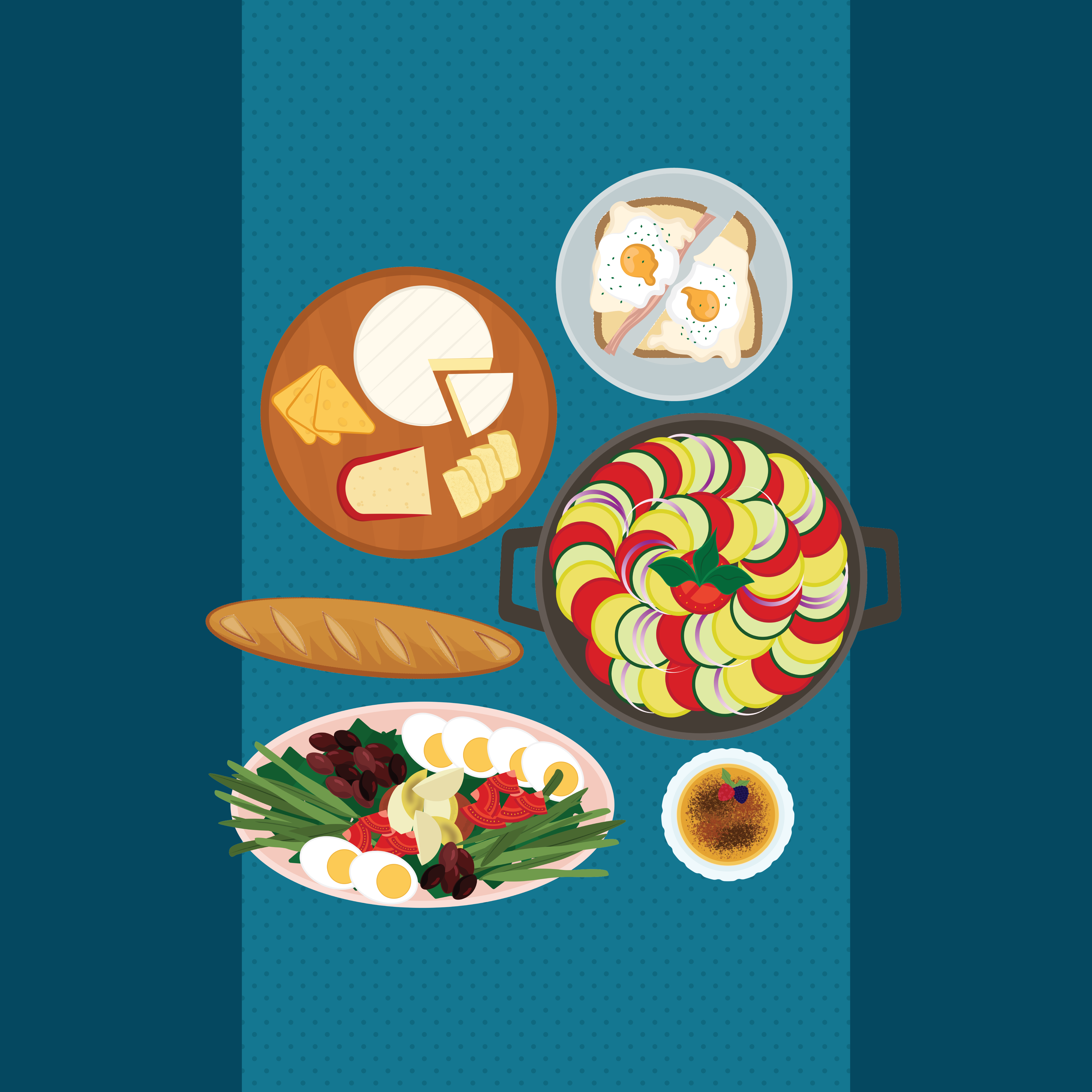Summary
In this lesson, students will explore some culinary aspects of French culture to learn about stereotypes and how learning about other cultures affects our conception of others. Students will define the word “stereotype.” After doing so, they will share stereotypes they have regarding French food, watch a few videos that will explain or dispel those stereotypes, and come to an understanding of how to move beyond stereotypes. When they have finished the discussion, they will construct a menu for a French dinner and then describe their selections and why they chose them in French.
Essential Question(s)
What are stereotypes? How does learning about other cultures affect our conception of others?
Snapshot
Engage
Students anticipate learning by completing a Collective Brain Dump about stereotypes.
Explore
Students discuss French food using the I Think / We Think strategy.
Explain
Students compare French and American food by watching a video and completing a T-Chart.
Extend
Students investigate the nature of stereotypes by completing a Quick Write.
Evaluate
Students design a menu for a French dinner they would serve to their friends.
Materials
Lesson Slides (attached)
I Think / We Think T-Chart (attached; one per student)
French Meal handout (attached; one per student)
Projector
Speaker for audio playback (Bluetooth or other)
Internet-connected devices for each student, such as a tablet or phone
Printer paper
Pencils or pens
Engage
5 Minute(s)
Use the attached Lesson Slides to guide the lesson. Show slides 2–4 to introduce the topic, essential questions, and learning objectives. Display slide 5, and introduce the Collective Brain Dump strategy and the Mentimeter tech tool.
Allow students around one minute to enter their answers to the question, “What are stereotypes?” Have the Word Cloud displayed so students can see their answers populate on the screen as they are submitted. Highlight a few of the largest words, and ask students why they think that was a common answer.
Explore
10 Minute(s)
Display slide 6, and introduce the I Think / We Think strategy. Distribute the attached I Think / We Think T-Chart handout with the question, “What are some characteristics of French food? What kinds of foods do you think French people like to eat?”
Have students fill out the left side of the handout (“I Think…”) on their own. After giving them ample time to do so, have students discuss in small groups and fill out the right side of the handout (“We Think…”). If there is sufficient time, have a short class discussion, and let a few groups share out.
Explain
20 Minute(s)
Show slide 7 with the image of a U.S. and French Foods T-Chart. Have students draw the same T-Chart on a sheet of notebook paper. In partners, let students discuss what they know about American food, and have them write some traits and examples on the U.S. side of the T-Chart. Then, display slides 8–9, showing the following two videos on French food.
Display slide 10. Break students into small groups, and have them fill out the French side of their T-Chart with what they now know about French food. This will help them clear up any misconceptions they may have had in the first activity. Then have students discuss in groups the similarities and differences between French and American food. Generate a class discussion by letting a few groups share out, and be sure to clear up misconceptions as they arise.
Extend
10 Minute(s)
Display slide 11, and introduce the Quick Write strategy. Ask students to answer the prompt: “What are stereotypes? How do they affect the ways we think about and treat each other? Do stereotypes help us get to know people? If not, how can you move beyond stereotypes when learning about different peoples and cultures?”
Allow students 10 minutes for this quick write. Once time has elapsed, have students share their writing with an elbow partner. Allow students to read their partners’ work, and then give them another five minutes to discuss. Allow a few groups to share out.
Evaluate
10 Minute(s)
Display slide 12, and distribute the attached French Meal handout. Read through the instructions with students, and answer any clarifying questions. Students should write their plan for the meal along with their rationale in French on the front and then use the back to construct their ornate menu design. Allow students the remainder of the hour to work on this along with some time during the next class period to finish if necessary.
Resources
Easy French. (2021, May 15). Famous French food French people actually hate | Easy French 128 [Video]. YouTube. Retrieved March 16, 2023, from https://www.youtube.com/watch?v=nLX8-ORCS-4
Edukale by Lucie. (2020, November 13). EMILY IN PARIS FOOD STEREOTYPES: true or false? French nutritionist reacts! | Edukale [Video]. YouTube. Retrieved March 16, 2023, from https://www.youtube.com/watch?v=5QCMQOxmJjM&t=429s
K20 Center. (n.d.). Collective brain dump. Strategies. https://learn.k20center.ou.edu/strategy/111
K20 Center. (n.d.). I think / We think. Strategies. https://learn.k20center.ou.edu/strategy/141
K20 Center. (n.d.). Mentimeter. Tech Tools. https://learn.k20center.ou.edu/tech-tool/645
K20 Center. (n.d.). Quick write. Strategies. https://learn.k20center.ou.edu/strategy/1127
K20 Center. (n.d.). T-chart. Strategies. https://learn.k20center.ou.edu/strategy/86
Mentimeter. (2020, June 22). How to create word clouds for free - Live & interactive - Mentimeter [Video]. YouTube. https://www.youtube.com/watch?v=GLRZ_FGDATY&t=67s
Merriam-Webster. (n.d.). Stereotype. Merriam-Webster.com Dictionary. Retrieved March 16, 2023, from https://www.merriam-webster.com/dictionary/stereotype


